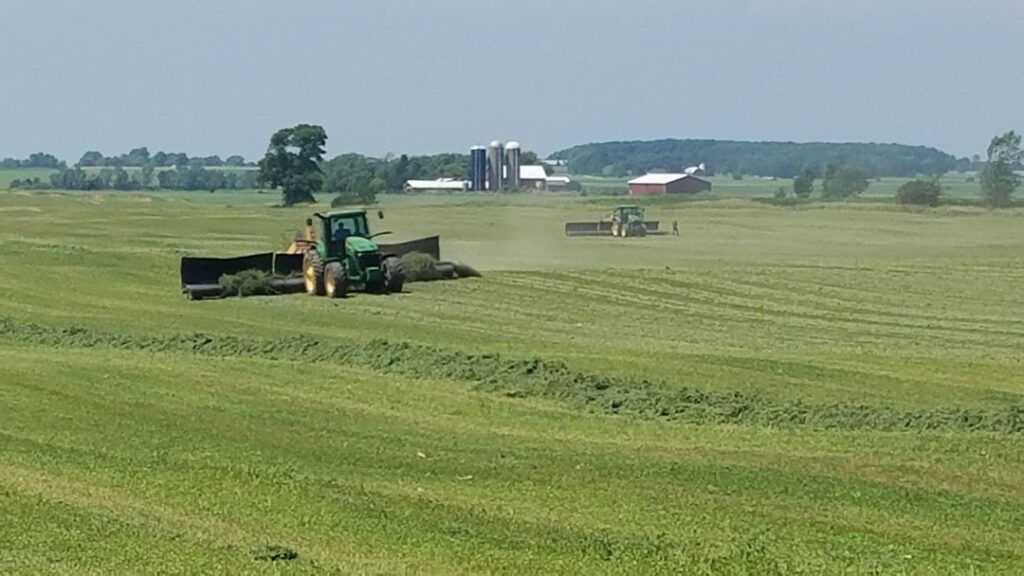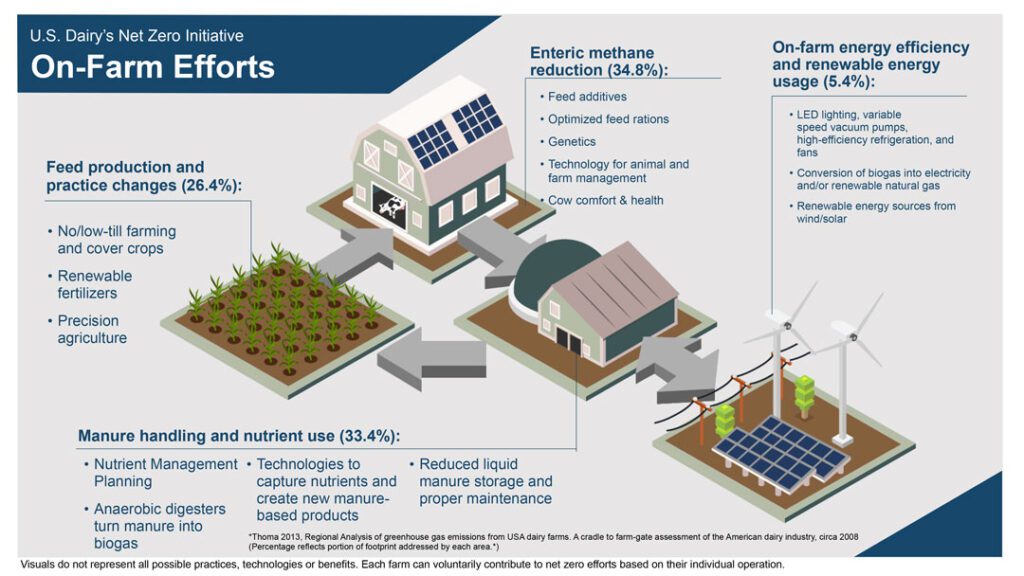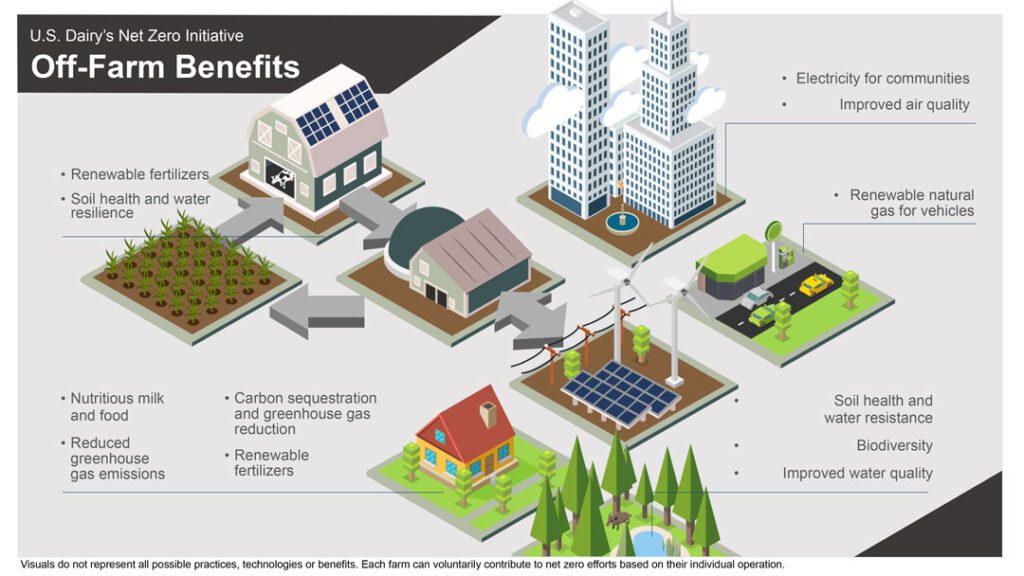Share this page
U.S. Dairy net zero initiative
actionable pathway on farm to being an environmental solution


Alignment with SDGs
AUTHOR
Jamie Jonker, Ph.D.1,2, Nicholas Gardner3,2
1National Milk Producers Federation, Arlington, VA, USA. 2US IDF, Fitchburg, WI, USA. 3U.S. Dairy Export Council, Arlington, VA, USA
Abstract
Imagine a world where dairy is seen as an environmental solution. Dairy presents solutions for today’s nutrition and environmental challenges. It provides accessible and affordable nutrition while sequestering carbon and improving soil health through improved land use systems; reducing greenhouse gas emissions through feed management, manure management, energy efficiency; and by generating renewable energy that powers the farm and homes and businesses.
With this vision in mind, the Net Zero Initiative (NZI) launched in 2020 as an industry-wide effort to accelerate voluntary action on farm to reduce environmental impacts by making sustainable practices and technologies more accessible and affordable to U.S. dairy farms of all sizes and geographies. This is achievable through existing and new partnerships where research, on-farm pilots, new manure-based products and ecosystem markets are developed, and by creating farmer technical support programs to share learnings and scale outcomes.
Introduction
NZI is a coordinated and collaborative national platform informed by and designed for U.S. dairy producers – representing more than 31,000 independent farms, 95% of which are family-owned, and covering more than 15 million acres. Given the central role that farmers play in food production, research, and innovation, including their voice at the table helps to ensure the ability to feed the next generation and ensure practical and economically viable environmental solutions.
Many technologies and practices that reduce farm environmental impacts are already available and some are widely employed today. NZI looks to break down barriers to accelerate more widespread adoption, such as addressing the economic viability of technology and practices. This can be achieved by realizing untapped value on-farm including sequestering carbon, converting manure and waste into nutrient-rich fertilizer, renewable energy and other valuable products, and contributing to ecosystem markets making more offsets available.
Materials and methods
In 2008, the U.S. dairy industry was the first in the food agricultural sector to conduct a full life cycle assessment at a national scale1,2. In 2020, the Innovation Center for U.S. Dairy set aggressive environmental sustainability goals to collectively achieve carbon neutrality or better, optimize water usage and improve water quality by 2050, with a commitment for quantitative and credible measures of progress reporting every five years. As collective goals, not every farm, cooperative or processor is expected to reach these goals individually, but together the industry can leverage its diversity to meet them.
The farm-field strategy of these goals is termed the Net Zero Initiative (NZI). The intention of NZI is to remove barriers that stand in the way of all dairy farmers adopting best practices and technologies that advance sustainable food systems and garner recognition and sufficient compensation for the environmental assets they manage and enhance on their farms. The work of NZI is focused in four areas: feed production, enteric methane reduction, energy efficiency and manure management – which together represent the total footprint of a farm.
Success requires addressing the affordability of technology and practice solutions, closing the gaps on data and research for more quantifiable outcomes, and making solutions accessible to farms of all sizes. There are three tracks that are carrying out this work: Groundwork to address the foundational research gaps in modeling and measurement, Dairy Scale for Good to provide an economic and environmental viability study and Collective Impact to support widespread adoption.






The global dairy sector is already part of the solution to limit climate change. This initiative advances environmental solutions on farms and create economically-viable, scalable pathways to accelerate progress.
Dr. Jamie Jonker Tweet
Results
The primary expected outcomes include 1) the collective U.S. dairy industry advances to net zero carbon emissions and significant improvements in water use and quality, 2) in addition to nutrient-dense foods and beverages, dairy farms provide products and services that enable other industries and communities to be more sustainable, and 3) farmers are able to realize the untapped value on-farm, making the system of continuous improvement self-sustaining.
Discussion
NZI was established to unite the assets and expertise of dairy trade, professional and industry organizations and their constituents toward a shared objective. The founding partner organizations are Dairy Management, Inc., Innovation Center for U.S. Dairy, International Dairy Foods Association, National Milk Producers Federation, Newtrient and U.S. Dairy Export Council.
NZI is a collaboration of the U.S. dairy community, corporate partners, research institutions, nongovernmental organizations and other stakeholders. This unprecedented partnership brings together diverse expertise and perspectives to strengthen its plan and realize its full potential for dairy to be an environmental solution, with benefits both on and off farm.
This is a pioneering effort – if solved for dairy, the learnings can be transferred to other parts of agriculture, becoming a catalyst for broader change.
Conclusion
The result of this work is transformative and reinforces the important role of dairy in sustainable food systems, making nutrient-dense foods more readily accessible. Through leveraging industry-wide collaboration and cross-sector partnerships, the U.S. dairy industry is equipped to advance environmental solutions on farms and create economically-viable, scalable pathways to accelerate progress. Successes and learning from NZI can not only benefit dairy but inform similar approaches across agriculture to advance a sustainable 21st century food system.
References
G. Thoma ,J. Popp, D. Shonnard, D. Nutter, M. Matlock, R. Ulrich, W. Kellogg, D. Soo Kim, Z. Neiderman, N. Kemper, F. Adom, C. East. Regional analysis of greenhouse gas emissions from USA dairy farms: A cradle to farm-gate assessment of the American dairy industry circa 2008. Int. Dairy J. 2013. (31) S29 – S40.
G.Thoma, J. Popp, D. Nutter, D. Shonnard, R. Ulrich, M. Matlock, D. Soo Kim, Z. Neiderman, N. Kemper, C. East, F. Adom. Greenhouse gas emissions from milk production and consumption in the United States: A cradle-to-grave life cycle assessment circa 2008. Int. Dairy J. 2013. (31) S3 – S14






